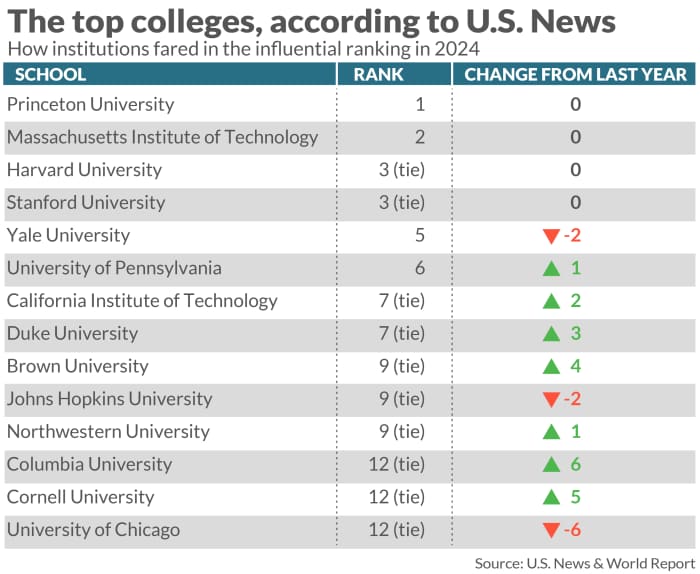This post was originally published on this site
U.S. News released its influential undergraduate college rankings Monday, a list that continues to inspire both fascination and derision.
Despite a change in methodology partially in response to recent criticisms, the same Ivy League and highly selective institutions still dominate the top of the list, even though there’s been some significant moves among the top-14 ranked schools.

For years, college officials have complained behind closed doors that the U.S. News rankings incentivize behavior that’s not always in the best interest of students. This year, the U.S. News rankings even became a target of Secretary of Education Miguel Cardona.
“It’s time to stop worshiping at the false altar” of the U.S. News rankings, Cardona said at a gathering of law schools convened by Harvard and Yale to talk about how best to share data after those two schools and others left the U.S. News law school rankings last year. “Colleges spend enormous resources chasing rankings they feel carry prestige, but in practice, just Xerox privilege and drive-up costs.”
Despite the exodus of top law and medical schools from the professional rankings, undergraduate colleges — even some whose professional schools defected — are still largely participating in the highly influential undergraduate rankings.
Columbia University was probably the highest profile school to say it wouldn’t share undergraduate data with U.S. News. That announcement, earlier this year, came after the school dropped from No. 2 to No. 18, in the wake of an analysis from one of the school’s math professors alleging the school submitted “highly misleading” statistics to the publication. Columbia later acknowledged that the data it sent to U.S. News was flawed.
This year, Columbia tied for the No. 12 spot.
Other major movers near the top of the list include the University of Chicago, which fell six spots to No.12, and Duke University, which climbed three spots to No. 7. Duke’s move up the rankings comes a little more than a week after the New York Times called the school “one of the least economically diverse in the country.” The piece echoed concerns expressed by some college leaders and Cardona — that devoting resources to things that can help a school climb the rankings may be in tension with providing benefits to students, particularly low-income ones.
Duke’s president, Vincent Price, said in a statement responding to the article that the school cares “deeply about socioeconomic diversity,” while acknowledging that the Duke has “more work to do in this area.” He cited efforts that are already underway that have “yielded significant positive results,” including expanding financial aid for students from the Carolinas.
“While we certainly have more yet to do, I am proud of the many ways our faculty, staff, student leaders and administrators are together striving to make Duke a more accessible and supportive community for students from all backgrounds,” Price said.
The University of Chicago did not immediately respond to a request for comment.
Much of the broader controversy surrounding U.S. News rankings in higher education policy circles has centered around the idea that factors that have traditionally played a role in the rankings, like selectivity, standardized test scores and spending per student, reflect an institution’s wealth and the wealth of the students who attend. Instead, critics have said rankings and the higher education community should focus more on how colleges improve students’ chances of success.
“Higher education should measure what matters, not just what’s become tradition to measure,” said Diane Cheng, vice president of research and policy at the Institute for Higher Education Policy. “We should recognize and celebrate colleges that help their students.”
Changes in U.S. News’s methodology this year appear to be a response to some of those concerns. More than half of a school’s ranking is based on measures of post-graduate success, including graduation rates for first-generation and low-income students. The publication dropped acceptance rate as a metric a few years ago, and this year stopped counting class size, alumni giving and three other factors schools had derided.
These changes and the proliferation of other rankings that focus on social mobility are all “in the right direction,” Cheng said. Still, she noted that “the colleges that are providing economic mobility are not often the ones that are claiming the spotlight in some of these high-profile rankings.”
The changes to U.S. News’ methodology did help give many schools a boost, the publication noted. For example, Rutgers University at New Brunswick, the flagship campus of New Jersey’s biggest public university, cracked the top 40 for the first time in part because of the uptick in the weight the rankings place on enrolling and graduating students from economically diverse backgrounds, the publication said. The N.J. school was tied at No. 40 with the University of Washington and Tufts University, which fell from last year’s ranking of No. 32.
U.S. News also highlighted schools that jumped more than 50 spots thanks to the methodology change. Still, to Cheng’s point, none of them cracked the top 150 schools on the list.

